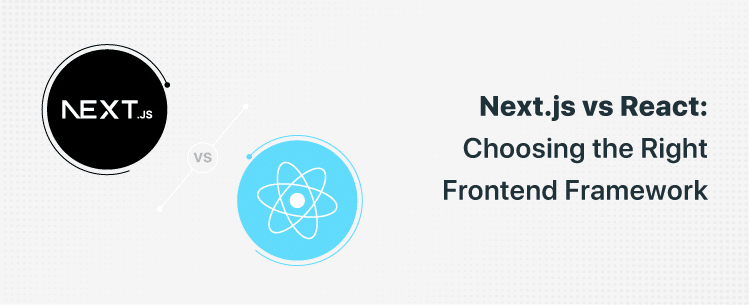
Introduction
New technologies are released daily, whether for web or mobile, frontend or backend. Two such popular frontend development frameworks are Next JS and React JS. Programmers and businesses widely prefer the two JavaScript frameworks as they enable them to develop flexible and user-friendly frontends.
The blog compares Next.js and React, exploring their key features, use cases, and benefits. We will delve into the advantages and considerations of each framework to help you determine which is the best fit for your project requirements.
What is Next.js?

React-based framework Next.js is open-source and simplifies creating dynamic websites displayed on the server. Next.js enables programmers to construct web apps that are both scalable and quick to respond to user input.
Next.js manages server-side rendering efficiently and allows the program to run without client-side software. Also, Next.js helps create and maintain large-scale online applications.
What is React?

Facebook developed React, a free and open-source toolkit for creating elaborate UIs. React enables programmers to create dynamic and flexible user interfaces quickly.
As a result, developers may create fast and responsive user interfaces with dynamic interactions. In addition, React can handle both client- and server-side rendering. As a result, it allows developers to build sophisticated and user-friendly single-page apps.
What are some advantages and disadvantages of Next.js?
Next.js offers several advantages and disadvantages. Here are some pros and cons of using Next.js:
Pros of Next.Js
Server-Side Rendering (SSR) and Static Site Generation (SSG): Next.js has SSR and SSG capabilities, allowing for faster initial page loads, enhanced SEO, and a better user experience.
Next.js automatically breaks your JavaScript code into smaller parts and only loads the code required for each page, resulting in faster page rendering and lower load times.
Built-in Routing: Next.js includes routing capabilities that make creating dynamic and nested routes for your application simple.
TypeScript Integration: Next.js offers good TypeScript integration, which can increase code quality, type checking, and developer efficiency.
API Routes: Next.js allows you to construct serverless API routes within your application, making backend development easier.
Rich Ecosystem and Community: Because Next.js has a huge and active community, there are many libraries, plugins, and resources available to extend and improve your application.
Cons of Next.js Use
It is also important to consider the drawbacks of Next.js before making a final decision in choosing the right framework.
Steep Learning Curve: Next.js has a steep learning curve, especially if you’re new to React or web programming. Understanding Next.js ideas and recommended practices may take some time and effort.
Complexity: While Next.js streamlines several parts of web development, it adds complexity compared to simpler frameworks. Managing server-side rendering, data fetching, and routing may necessitate a more in-depth knowledge of Next.js.
Build Time: If you have a large application or extensive build needs, Next.js build times may be longer than those of simpler frameworks. This may affect the development iteration pace.
Server-Side Requirements: To fully utilize Next.js’s capabilities, including server-side rendering and API routes, you must have a server environment or infrastructure.
What are some benefits and drawbacks of using React?
React has become a popular choice among developers thanks to the many advantages it offers. Here is a detailed list of the advantages and disadvantages of adopting React.
Pros of React
Component-Based Architecture: The component-based architecture of React encourages reuse and modularity. Components isolate their functionality and UI, making complicated user interfaces easier to create and maintain.
Virtual DOM: React uses a virtual DOM, an in-memory version of the actual DOM. When there are updates, React can efficiently update only the necessary components of the UI, resulting in better performance and a smoother user experience.
One-Way Data Binding: React uses a unidirectional data flow, which helps to keep state management predictable and makes it easier to debug and understand how data changes throughout the application.
Large Ecosystem: React has a large ecosystem, with multiple libraries, tools, and community support accessible. This implies that developers may access many resources, third-party components, and solutions to common problems.
Mobile Development: React Native, a framework developed on top of React, allows for creating native iOS and Android mobile applications using JavaScript. Developers can create mobile apps with a shared codebase by leveraging React knowledge.
To maximize the potential of your application and gain a competitive edge in today’s market, consider hiring professional React.js developers or a React.js app development company. These experts can deliver a higher level of expertise, ensuring your business app reaches its full potential and stands out in the competitive landscape.
Cons of React
Steep Learning Curve: Beginners have a steep learning curve because React demands a basic mastery of JavaScript and web development concepts. If you’re new to web development, React may be intimidating, so start with the fundamentals before going into React.
Considerations for Performance: While React is known for its performance optimizations, poorly optimized React components or inefficient state management can cause performance issues. To offer a seamless user experience, component rendering and state updates must be optimized.
Tooling Complexity: React is only a library, so it must provide a complete solution for developing applications. Additional tools and libraries for routing, state management, and build procedures are frequently required by developers, which might complicate the development workflow.
JSX syntactic: React’s syntactic extension, JSX, blends JavaScript and HTML-like markup. While JSX can make components more legible and maintainable, it may feel strange to developers using traditional HTML templates.
The benefits and drawbacks of React depend on individual experiences, project requirements, and the wider development ecosystem. The benefits of React frequently outweigh the drawbacks, making it a popular choice for developing interactive and scalable web apps.
Now when you are well aware of the advantages and drawbacks of both Next.js and React, it’s time to see the differences between them.
Next.js vs. React- Detailed Comparison
We have compared both frameworks based on performance, developers’ community, configuration, and speed to help you make an informed choice.

- Performance: Next.js v React
Next.js is a static site generator. Static websites are frequently the quickest to load. Their pages are generated on the fly, cached, and served via a content delivery network.
The default React configuration uses sluggish client-side rendering. Yet, different rendering approaches are possible. The only real distinction is the additional effort necessary to get it up and running.
- Configuration: Next.js v React
React is tight about code structure and mandates using custom or external frameworks. It may be inconvenient and hinder the progress of your project.
The advantage is that React is straightforward to learn and apply. So developers can easily learn it or any new additions. As a result, while React may be more configurable, it may still be the best choice for your assignment.
- Developers community
Because React has been around longer, it has a larger fan base and community that helps developers by providing tutorials and other resources as they work on various projects.
The Next.js community, on the other hand, is substantially smaller and has fewer developers. This may restrict you from viewing the latest material on platform faults, issues, and solutions, which may be critical if you encounter problems.
- Speed of coding
Next.js’s main advantage over React is that it requires less coding from developers. Next.js is based on React, but it includes many tools that make it simple for developers to create pages and attach them to component headers.
Meanwhile, React uses its large and strong library to speed up development. Furthermore, it provides a framework called Create React App that can be used to integrate its library into websites further.
Which framework is suitable for your project?
According to Statista, 42.62% of developers use React.js, whereas just 13.52% use Next.js. When deciding between React and Next.js, evaluating the project’s or problem’s specific requirements is critical. While React is excellent in most scenarios, there are times when Next.js is preferable.
Next.js, for example, aids in the building of static websites and applications that do not require complex routing because it simplifies many development processes and has native support for server-side rendering.
However, if you’re working on a large-scale project that requires dynamic routing and heavily data-driven components, React may be a better solution. Finally, the choice between Next.js and React is determined by the characteristics of your project.
Conclusion
We hope the blog and the side-by-side comparison can help you decide which tool is appropriate for your next project or, as a new developer, which next step in your career.
Next.js is a framework built on top of React with powerful features to streamline the development process. On the other hand, React is a JavaScript library developed by Facebook, known for its component-based architecture and virtual DOM rendering.
Building a functional web application is a difficult task. To produce user-friendly software that performs successfully, you must have focus, commitment, and high technical and design knowledge. Both frameworks may provide developers with anything they need, whether a simpler platform or the ability to create basic and advanced web applications.
Choose the best framework for your next development project by balancing your needs against the advantages and disadvantages of each framework. If you still need support or expert advice to choose the right framework, contact us. At Valuetree, our professional front-end experts can help you with expert consultation.
FAQs
Do I need to learn React before using Next.js?
Yes, it is recommended to have a solid understanding of React before diving into Next.js. Next.js builds upon React and extends its capabilities, so familiarity with React concepts and syntax is essential.
When should I use Next.js instead of React?
Next.js is beneficial when you require server-side rendering or static site generation, need built-in routing capabilities, want to leverage TypeScript support or create serverless API routes within your application. If your project doesn’t require these features and you only need a client-side rendering solution, using React alone may suffice.
Is Next.js a replacement for React?
No, Next.js is not a replacement for React. Next.js complements React by providing additional functionality and features that simplify server-side rendering, routing, and other aspects of building web applications. React is still the core library for building UI components in Next.js.
Can I use React with Next.js?
Absolutely! Next.js is built on React so that you can use React components and libraries seamlessly within a Next.js application. Next.js encourages using React components to build the user interface.
Can I migrate an existing React application to Next.js?
Yes, it is possible to migrate an existing React application to Next.js. Next.js provides an easy migration path by leveraging existing React components and gradually introducing Next.js features like server-side rendering or static site generation to enhance the application.
